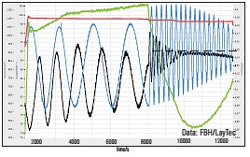- News
28 June 2016
LayTec offers EpiTT 280nm reflectance channel to sense AlGaN surface morphology in UV-C LED epi
Aluminium gallium nitride (AlGaN) buffer layers with high aluminium content are necessary for optimal UV-C LED performance. But their band-edge lies below 300nm, so established 405nm in-situ reflectance is insensitive to the surface morphology of such AlGaN layers. To monitor precisely both the AlGaN growth rate and surface morphology during UV-C LED epitaxy, in-situ metrology system maker LayTec AG of Berlin, Germany is hence offering an additional 280nm reflectance channel that employs a UV-C LED as a light source.
The Figure shows the results measured in-situ during growth of an AlGaN layer: The Fabry-Perot oscillations of the final AlGaN layer are damping out because the band edge of the material shifts toward longer wavelengths at the growth temperature. The small reflectance reduction at 12,000s indicates a small roughening of the AlGaN surface. The green line delivers the high-resolution wafer bow data.
This study is supported by Advanced UV for Life funding (grant number 03ZZ0105C) from the German Federal Ministry of Education and Science (BMBF).
EpiCurveTT Gen3: high-resolution wafer bow measurements for CCS reactors
Detecting thin-film strain in-situ during epitaxial growth through the tiny openings of the showerhead view-ports of a metal-organic chemical vapor deposition (MOCVD) reactor is a challenge, notes LayTec. However, the firm says that, by using advanced software algorithms, it has improved the signal-to-noise ratio of its EpiCurveTT tool by a full order of magnitude.
 Figure 1: Growth of AlN/AlGaN(60%Al) on a sapphire/AlN template in an Aixtron CCS 6x2 reactor: black – 280nm reflectance; blue – 405nm reflectance; green – high-resolution wafer bow; red – true temperature.
Figure 1: Growth of AlN/AlGaN(60%Al) on a sapphire/AlN template in an Aixtron CCS 6x2 reactor: black – 280nm reflectance; blue – 405nm reflectance; green – high-resolution wafer bow; red – true temperature.
The wafer bow data in Figure 1 (green line) shows that the wafer curvature noise in the Close Coupled Showerhead (CCS) reactor is now down to 0.3km-1. With this improvement, in-situ strain balancing or tuning the AlGaN lattice constant (Figure 2, strain changes from compressive to tensile during AlGaN growth at about 1000s) is now possible with accuracy levels formerly known only for ex-situ x-ray diffraction (XRD) methods, says the firm.
LayTec Metrology MOCVD UV LEDs AlGaN


